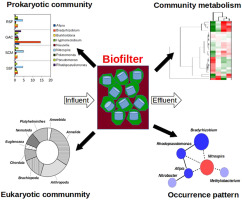当前位置:
X-MOL 学术
›
Water Res.
›
论文详情
Our official English website, www.x-mol.net, welcomes your
feedback! (Note: you will need to create a separate account there.)
Metagenomic characterization of biofilter microbial communities in a full-scale drinking water treatment plant
Water Research ( IF 11.4 ) Pub Date : 2017-10-28 , DOI: 10.1016/j.watres.2017.10.054 Seungdae Oh , Frederik Hammes , Wen-Tso Liu
Water Research ( IF 11.4 ) Pub Date : 2017-10-28 , DOI: 10.1016/j.watres.2017.10.054 Seungdae Oh , Frederik Hammes , Wen-Tso Liu

|
Microorganisms inhabiting filtration media of a drinking water treatment plant can be beneficial, because they metabolize biodegradable organic matter from source waters and those formed during disinfection processes, leading to the production of biologically stable drinking water. However, which microbial consortia colonize filters and what metabolic capacity they possess remain to be investigated. To gain insights into these issues, we performed metagenome sequencing and analysis of microbial communities in three different filters of a full-scale drinking water treatment plant (DWTP). Filter communities were sampled from a rapid sand filter (RSF), granular activated carbon filter (GAC), and slow sand filter (SSF), and from the Schmutzdecke (SCM, a biologically active scum layer accumulated on top of SSF), respectively. Analysis of community phylogenetic structure revealed that the filter bacterial communities significantly differed from those in the source water and final effluent communities, respectively. Network analysis identified a filter-specific colonization pattern of bacterial groups. Bradyrhizobiaceae were abundant in GAC, whereas Nitrospira were enriched in the sand-associated filters (RSF, SCM, and SSF). The GAC community was enriched with functions associated with aromatics degradation, many of which were encoded by Rhizobiales (∼30% of the total GAC community). Predicting minimum generation time (MGT) of prokaryotic communities suggested that the GAC community potentially select fast-growers (<15 h of MGT) among the four filter communities, consistent with the highest dissolved organic matter removal rate by GAC. Our findings provide new insights into the community phylogenetic structure, colonization pattern, and metabolic capacity that potentially contributes to organic matter removal achieved in the biofiltration stages of the full-scale DWTP.
中文翻译:

大型饮用水处理厂中生物滤池微生物群落的元基因组学表征
居住在饮用水处理厂过滤介质中的微生物可能是有益的,因为它们会代谢自来水和消毒过程中形成的有机可降解有机物,从而产生生物稳定的饮用水。然而,哪些微生物菌落定殖在过滤器上以及它们具有什么代谢能力仍有待研究。为了深入了解这些问题,我们在大型饮用水处理厂(DWTP)的三种不同过滤器中进行了元基因组测序和微生物群落分析。从快速砂滤器(RSF),颗粒活性炭滤器(GAC)和慢速砂滤器(SSF)以及Schmutzdecke取样(SCM,在SSF顶部积累的生物活性浮渣层)。对群落系统发育结构的分析表明,滤池细菌群落分别与源水和最终污水群落明显不同。网络分析确定了细菌群的特定过滤器定植模式。慢生根瘤菌在GAC中含量很高,而硝化螺菌则富含与沙子相关的过滤器(RSF,SCM和SSF)。GAC社区丰富了与芳香族化合物降解相关的功能,其中许多是由根瘤菌编码的(约占GAC社区总数的30%)。预测原核生物的最小生成时间(MGT)表明,GAC社区有可能在四个过滤器社区中选择速生植物(MGT小于15小时),这与GAC去除有机物的最高去除率一致。我们的发现为社区系统发育结构,定殖模式和代谢能力提供了新的见解,这些潜力可能有助于在大规模DWTP的生物过滤阶段实现有机物去除。
更新日期:2017-10-28
中文翻译:

大型饮用水处理厂中生物滤池微生物群落的元基因组学表征
居住在饮用水处理厂过滤介质中的微生物可能是有益的,因为它们会代谢自来水和消毒过程中形成的有机可降解有机物,从而产生生物稳定的饮用水。然而,哪些微生物菌落定殖在过滤器上以及它们具有什么代谢能力仍有待研究。为了深入了解这些问题,我们在大型饮用水处理厂(DWTP)的三种不同过滤器中进行了元基因组测序和微生物群落分析。从快速砂滤器(RSF),颗粒活性炭滤器(GAC)和慢速砂滤器(SSF)以及Schmutzdecke取样(SCM,在SSF顶部积累的生物活性浮渣层)。对群落系统发育结构的分析表明,滤池细菌群落分别与源水和最终污水群落明显不同。网络分析确定了细菌群的特定过滤器定植模式。慢生根瘤菌在GAC中含量很高,而硝化螺菌则富含与沙子相关的过滤器(RSF,SCM和SSF)。GAC社区丰富了与芳香族化合物降解相关的功能,其中许多是由根瘤菌编码的(约占GAC社区总数的30%)。预测原核生物的最小生成时间(MGT)表明,GAC社区有可能在四个过滤器社区中选择速生植物(MGT小于15小时),这与GAC去除有机物的最高去除率一致。我们的发现为社区系统发育结构,定殖模式和代谢能力提供了新的见解,这些潜力可能有助于在大规模DWTP的生物过滤阶段实现有机物去除。











































 京公网安备 11010802027423号
京公网安备 11010802027423号